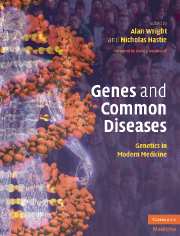Book contents
- Frontmatter
- Contents
- List of Contributors
- Foreword
- Section 1 Introductory Principles
- 1 Genes and their expression
- 2 Epigenetic modification of chromatin
- 3 Population genetics and disease
- 4 Mapping common disease genes
- 5 Population diversity, genomes and disease
- 6 Study design in mapping complex disease traits
- 7 Diseases of protein misfolding
- 8 Aging and disease
- 9 The MHC paradigm: genetic variation and complex disease
- 10 Lessons from single gene disorders
- 11 Environment and disease
- 12 Contemporary ethico-legal issues in genetics
- Section 2 Common Medical Disorders
- Index
- References
7 - Diseases of protein misfolding
Published online by Cambridge University Press: 17 August 2009
- Frontmatter
- Contents
- List of Contributors
- Foreword
- Section 1 Introductory Principles
- 1 Genes and their expression
- 2 Epigenetic modification of chromatin
- 3 Population genetics and disease
- 4 Mapping common disease genes
- 5 Population diversity, genomes and disease
- 6 Study design in mapping complex disease traits
- 7 Diseases of protein misfolding
- 8 Aging and disease
- 9 The MHC paradigm: genetic variation and complex disease
- 10 Lessons from single gene disorders
- 11 Environment and disease
- 12 Contemporary ethico-legal issues in genetics
- Section 2 Common Medical Disorders
- Index
- References
Summary
Introduction
The ability of even the most complex protein molecules to fold to their biologically functional states is perhaps the most fundamental example of biological self-assembly, one of the defining characteristics of living systems (Vendruscolo et al., 2003). The process of protein folding in the cellular environment can, in principle, begin whilst the nascent chain is still attached to the ribosome, and there is clear evidence that some proteins do fold at least partially in such a co-translational manner (Hardesty and Kramer, 2001). Other proteins are known to undergo the major part of their folding only after release from the ribosome, whilst yet others fold in specific cellular compartments such as the endoplasmic reticulum (ER) or mitochondria following translocation through membranes (Hartl and Hayer-Hartl, 2002). Although the fundamental principles underlying the mechanism of folding are unlikely to differ in any significant manner from those elucidated from in vitro studies, many details of the way in which individual proteins fold will undoubtedly depend on the environment in which they are located. In particular, as incompletely folded chains inevitably expose to the outside world many regions of the polypeptide molecule that are buried in the native state, such species are prone to inappropriate interactions with other molecules within the complex and crowded cellular environment. Such interactions can result both in the disruption of normal cellular processes and in self-association or aggregation.
- Type
- Chapter
- Information
- Genes and Common DiseasesGenetics in Modern Medicine, pp. 113 - 131Publisher: Cambridge University PressPrint publication year: 2007



